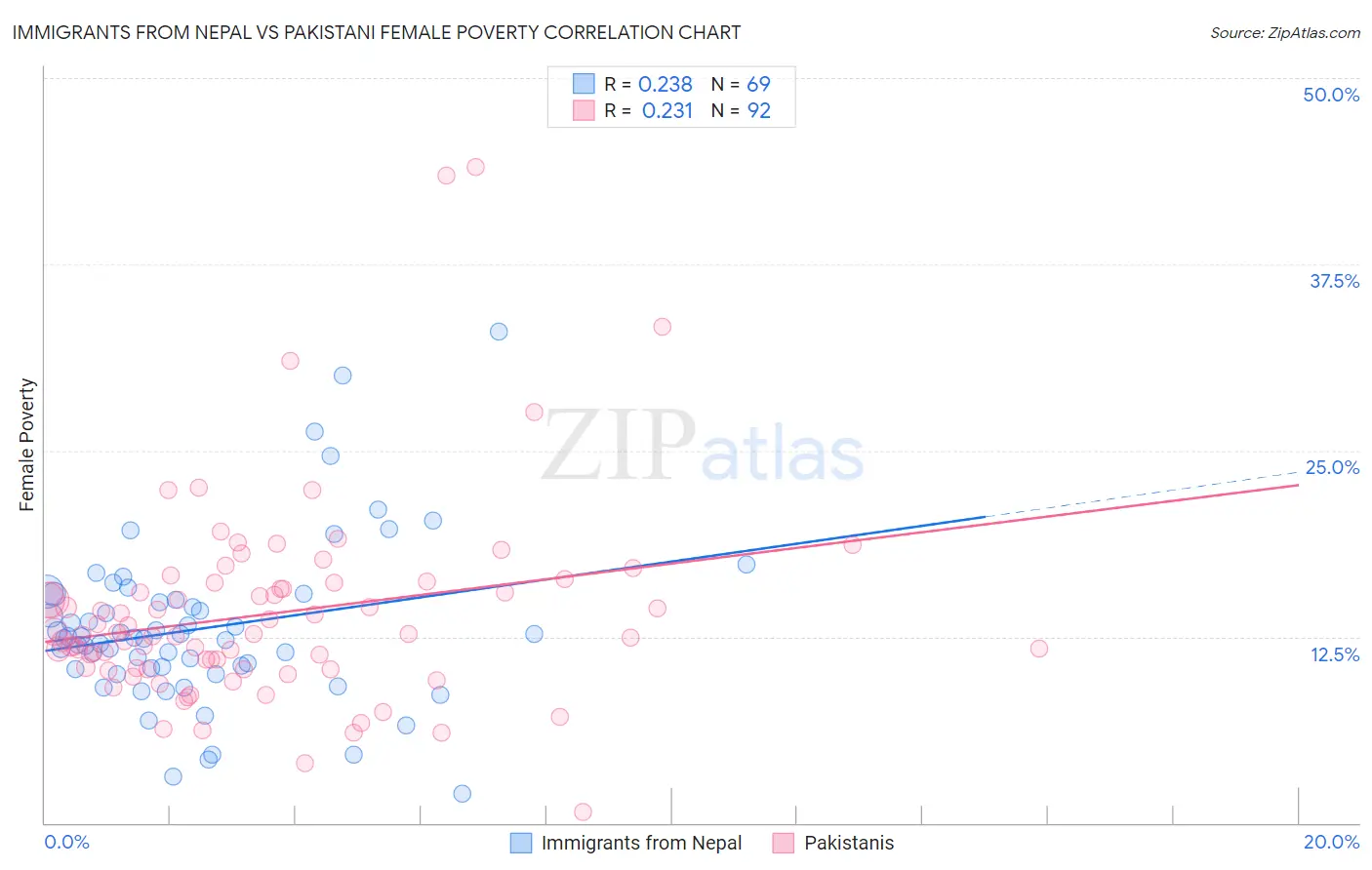Immigrants from Nepal vs Pakistani Female Poverty
COMPARE
Immigrants from Nepal
Pakistani
Female Poverty
Female Poverty Comparison
Immigrants from Nepal
Pakistanis
13.3%
FEMALE POVERTY
62.7/ 100
METRIC RATING
160th/ 347
METRIC RANK
12.9%
FEMALE POVERTY
83.0/ 100
METRIC RATING
140th/ 347
METRIC RANK
Immigrants from Nepal vs Pakistani Female Poverty Correlation Chart
The statistical analysis conducted on geographies consisting of 186,688,907 people shows a weak positive correlation between the proportion of Immigrants from Nepal and poverty level among females in the United States with a correlation coefficient (R) of 0.238 and weighted average of 13.3%. Similarly, the statistical analysis conducted on geographies consisting of 335,177,271 people shows a weak positive correlation between the proportion of Pakistanis and poverty level among females in the United States with a correlation coefficient (R) of 0.231 and weighted average of 12.9%, a difference of 2.7%.

Female Poverty Correlation Summary
| Measurement | Immigrants from Nepal | Pakistani |
| Minimum | 2.0% | 0.74% |
| Maximum | 33.0% | 44.1% |
| Range | 31.0% | 43.3% |
| Mean | 13.1% | 14.0% |
| Median | 12.4% | 12.7% |
| Interquartile 25% (IQ1) | 10.4% | 10.3% |
| Interquartile 75% (IQ3) | 15.2% | 15.9% |
| Interquartile Range (IQR) | 4.8% | 5.6% |
| Standard Deviation (Sample) | 5.5% | 6.8% |
| Standard Deviation (Population) | 5.5% | 6.7% |
Demographics Similar to Immigrants from Nepal and Pakistanis by Female Poverty
In terms of female poverty, the demographic groups most similar to Immigrants from Nepal are Costa Rican (13.3%, a difference of 0.090%), Pennsylvania German (13.2%, a difference of 0.50%), Immigrants from Northern Africa (13.2%, a difference of 0.67%), Immigrants from Bosnia and Herzegovina (13.2%, a difference of 0.77%), and Hungarian (13.2%, a difference of 0.82%). Similarly, the demographic groups most similar to Pakistanis are Icelander (13.0%, a difference of 0.32%), Brazilian (13.0%, a difference of 0.42%), Immigrants from Malaysia (13.0%, a difference of 0.44%), Afghan (13.0%, a difference of 0.53%), and Syrian (13.0%, a difference of 0.56%).
| Demographics | Rating | Rank | Female Poverty |
| Pakistanis | 83.0 /100 | #140 | Excellent 12.9% |
| Icelanders | 81.1 /100 | #141 | Excellent 13.0% |
| Brazilians | 80.5 /100 | #142 | Excellent 13.0% |
| Immigrants | Malaysia | 80.4 /100 | #143 | Excellent 13.0% |
| Afghans | 79.8 /100 | #144 | Good 13.0% |
| Syrians | 79.6 /100 | #145 | Good 13.0% |
| Immigrants | Peru | 79.1 /100 | #146 | Good 13.0% |
| Immigrants | Kazakhstan | 78.6 /100 | #147 | Good 13.0% |
| Yugoslavians | 76.9 /100 | #148 | Good 13.1% |
| Taiwanese | 75.7 /100 | #149 | Good 13.1% |
| Tsimshian | 75.5 /100 | #150 | Good 13.1% |
| Immigrants | Germany | 74.9 /100 | #151 | Good 13.1% |
| Samoans | 73.6 /100 | #152 | Good 13.1% |
| Immigrants | Fiji | 71.0 /100 | #153 | Good 13.2% |
| Armenians | 70.4 /100 | #154 | Good 13.2% |
| Hungarians | 70.1 /100 | #155 | Good 13.2% |
| Immigrants | Bosnia and Herzegovina | 69.7 /100 | #156 | Good 13.2% |
| Immigrants | Northern Africa | 68.8 /100 | #157 | Good 13.2% |
| Pennsylvania Germans | 67.3 /100 | #158 | Good 13.2% |
| Costa Ricans | 63.6 /100 | #159 | Good 13.3% |
| Immigrants | Nepal | 62.7 /100 | #160 | Good 13.3% |